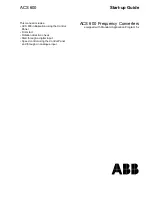
Glossary
96k frame
MADI sources with a sample rate of 88.2kHz or 96kHz can be configured to use the so-called
96k
frame
. If this frame is used, a sample rate of 88.2 or 96 kHz can be detected on the receiver side
automatically. When it is not used, or when higher sample rates are used, the receiver must always
be configured to the correct factor (x2, x4) since there is no other mechanism in MADI that allows
automatic detection.
AVB
Audio Video Bridging (AVB) is a common name for the set of technical standards developed by the
Institute of Electrical and Electronics Engineers (IEEE) Audio Video Bridging Task Group of the
IEEE 802.1 standards committee.
AVDECC
IEEE standard for device discovery and control. A protocol that is used by manufacturers to
control various settings of AVB endpoints.
AVDECC Controller
A software that discovers AVB entities and allows the user to access their settings and connect
them. Different AVDECC Controllers from different vendors can be used at the same time in the
same network.
Double speed
A sampling rate of 88.2 kHz or 96 kHz (compare single speed and quad speed)
AVB talker
An AVB endpoint that streams audio to one or more listeners.
AVB listener
An AVB endpoint that receives an audio stream from a talker.
DHCP server
A DHCP Server hands out IP addresses to network devices. Every consumer oriented WiFi Router
has a default DHCP Server handing out private addresses, usually 192.168.0.x. The IP address of a
network device must be known in order to communicate with it on Layer 3.
MADI
Multichannel Digital Audio Interface as defined in the AES 10 standard. Used to receive and
transmit up to 64 uncompressed audio channels over coaxial or fibre optic connection.
Master clock
Every digital audio transmission requires a clock which allows sender and receiver to be
synchronized. When two or more devices are connected, one device is configured to be the 'clock
master' (clock source: internal). All other devices are configured to be be 'slaves'. Synchronization
can either be established by dedicated cabling (word clock, 75 ohms coaxial cable), or by
recreating the clock from an incoming digital audio signal such as MADI or an AVB stream.
Quad speed
A sampling rate of 176.4 or 192 kHz (compare single speed and double speed).
RME M-32 DA Pro User’s Guide
61
| Glossary


































